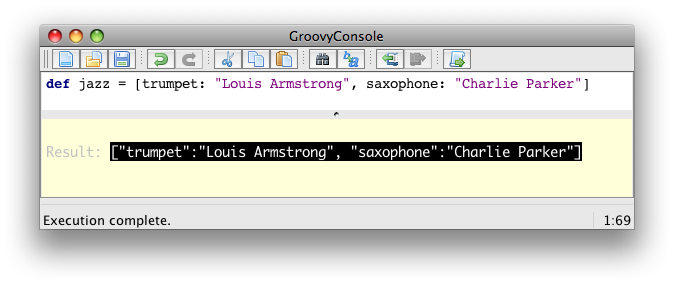import groovy.ui.Console;
...
Console console = new Console();
console.setVariable("var1", getValueOfVar1());
console.setVariable("var2", getValueOfVar2());
console.run();
...标签:
The Groovy Swing Console allows a user to enter and run Groovy scripts. This page documents the features of this user interface.

Groovy Console is launched via groovyConsole or groovyConsole.bat, both located in $GROOVY_HOME/bin
The Console has an input area and an output area.
You type a Groovy script in the input area.
When you select Run from the Actions menu, the console compiles the script and runs it.
Anything that would normally be printed on System.out is printed in the output area.
If the script returns a non-null result, that result is printed.
There are several shortcuts that you can use to run scripts or code snippets:
Ctrl+Enter and Ctrl+R are both shortcut keys for Run Script.
If you highlight just part of the text in the input area, then Groovy runs just that text.
The result of a script is the the value of the last expression executed.
You can turn the System.out capture on and off by selecting Capture System.out from the Actions menu
You can open any text file, edit it, run it (as a Groovy Script) and then save it again when you are finished.
Select File > Open (shortcut key ctrl+O) to open a file
Select File > Save (shortcut key ctrl+S) to save a file
Select File > New File (shortcut key ctrl+Q) to start again with a blank input area
You can pop-up a gui inspector on the last (non-null) result by selecting Inspect Last from the Actions menu. The inspector is a convenient way to view lists and maps.
The console remembers the last ten script runs. You can scroll back and forth through the history by selecting Next and Previous from the Edit menu. Ctrl-N and ctrl-P are convenient shortcut keys.
The last (non-null) result is bound to a variable named _ (an underscore).
The last result (null and non-null) for every run in the history is bound into a list variable named (two underscores). The result of the last run is [-1], the result of the second to last run is __[-2] and so forth.
The Groovy console is a very handy tool to develop scripts. Often, you will find yourself running a script multiple times until it works the way you want it to. However, what if your code takes too long to finish or worse, creates an infinite loop? Interrupting script execution can be achieved by clicking the interrupt button on the small dialog box that pops up when a script is executing or through the interrupt icon in the tool bar.

However, this may not be sufficient to interrupt a script: clicking the button will interrupt the execution thread, but if your code doesn’t handle the interrupt flag, the script is likely to keep running without you being able to effectively stop it. To avoid that, you have to make sure that the Script > Allow interruption menu item is flagged. This will automatically apply an AST transformation to your script which will take care of checking the interrupt flag (@ThreadInterrupt). This way, you guarantee that the script can be interrupted even if you don’t explicitly handle interruption, at the cost of extra execution time.
You can change the font size by selecting Smaller Font or Larger Font from the Actions menu
The console can be run as an Applet thanks to groovy.ui.ConsoleApplet
Code is auto indented when you hit return
You can drag’n’drop a Groovy script over the text area to open a file
You can modify the classpath with which the script in the console is being run by adding a new JAR or a directory to the classpath from the Script menu
Error hyperlinking from the output area when a compilation error is expected or when an exception is thrown
To embed a Swing console in your application, simply create the Console object, load some variables, and then launch it. The console can be embedded in either Java or Groovy code. The Java code for this is:
import groovy.ui.Console;
...
Console console = new Console();
console.setVariable("var1", getValueOfVar1());
console.setVariable("var2", getValueOfVar2());
console.run();
...Once the console is launched, you can use the variable values in Groovy code.
You can customize the way script output results are visualized. Let’s see how we can customize this. For example, viewing a map result would show something like this:

What you see here is the usual textual representation of a Map. But, what if we enabled custom visualization of certain results? The Swing console allows you to do just that. First of all, you have to ensure that the visualization option is ticked: View → Visualize Script Results — for the record, all settings of the Groovy Console are stored and remembered thanks to the Preference API. There are a few result visualizations built-in: if the script returns a java.awt.Image, a javax.swing.Icon, or a java.awt.Component with no parent, the object is displayed instead of its toString() representation. Otherwise, everything else is still just represented as text. Now, create the following Groovy script in ~/.groovy/OutputTransforms.groovy:
import javax.swing.*
transforms << { result ->
if (result instanceof Map) {
def table = new JTable(
result.collect{ k, v ->
[k, v?.inspect()] as Object[]
} as Object[][],
[‘Key‘, ‘Value‘] as Object[])
table.preferredViewportSize = table.preferredSize
return new JScrollPane(table)
}
}The Groovy Swing console will execute that script on startup, injecting a transforms list in the binding of the script, so that you can add your own script results representations. In our case, we transform the Map into a nice-looking Swing JTable. And we’re now able to visualize maps in a friendly and attractive fashion, as the screenshot below shows:

Groovy Console can visualize the AST (Abstract Syntax Tree) representing the currently edited script, as shown by the screenshot below. This is particularly handy when you want to develop AST transformations.

groovyConsole — the Groovy Swing console
标签:
原文地址:http://www.cnblogs.com/dream-to-pku/p/5472626.html